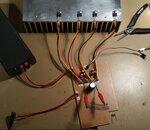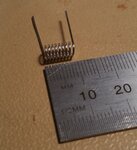David_
Advanced Member level 2
IR2110 Full-Bridge, heating coil heat distrubution experiment, what about dead-time?
Hello.
I have heard that if a heating coil(it isn't a coil as in inductance coil, it's simply a resistive heating element wound as a coil) is supplied with current in only one direction the heating of the coil is uneven on some ways, but that if the current is alternating in direction the heat distribution across the coil will even out.
I have no idea if that's true but it is relevant to a vaporizer project I have been talking about here though quite a while ago.
So I am setting up a experiment to test that.
My thought is to use a 12V @ 16A power supply(a former XBOX console power supply) to supply the current to a large 1Ω coil made out of 0,8mm thick SS316 wire by means of a H-bridge made with 2*IR2110 driving 4*IPP039N04L N-channel MOSFETs. With such a circuit I should be able to first supply the coil current by turning on/off only one current path through the H-bridge, and observe how the coil starts to glow as the heat gets very high, as if I where supplying the coil with a PWM signal. Then do the same thing again but this time every other PWM on-time will be supplied by one of the H-bridge current paths and the other on-time supply the current in the reverse direction with the other H-bridge current path.
Here is the circuit(I am about to go into my work room to dead-bug build the circuit):

I am thinking about how to generate the signals for the 4 MOSFETs, the first case in simply a PWM signal feeding into HIN1 and LIN2(or HIN2 and LIN1). But the second case is more difficult to think about how to generate in my mind.
I have a couple Arduino Due, a Digilent Analog Discovery and a Rigol arbitrary function generator, so I have plenty of options, but how to make those second case PWM singals most easily?
And what about dead-time? I have read that the diode and resistor that I have put in series with the MOSFETs gates is suppose to introduce some dead-time, but I can find no info on the validity of that statement, but many people have written online that the IR2110 includes dead-time in the circuit internally but the datasheet is not full of information, it does have some timing value that I don't understand what it is, it's named "Delay Matching, HS & LS Turn-On/Off" and is specified as 10nS.
I don't know how to determine the requirements for dead-time in this case, do I have to worry about that?
I have the MOSFETs on a monster heat-sink and the time that the MOSFETs will be switching shouldn't be more than 5-30 seconds(supplying the 1Ω resistance coil with 12V@12A should heat it up pretty quickly at a PWM frequency of 100kHz, but I might also use something more along 1kHz, in any case the heat up is going to happen quickly).
I will go and build it now but I would rather see what you think than simply trying it out...
Regards
Hello.
I have heard that if a heating coil(it isn't a coil as in inductance coil, it's simply a resistive heating element wound as a coil) is supplied with current in only one direction the heating of the coil is uneven on some ways, but that if the current is alternating in direction the heat distribution across the coil will even out.
I have no idea if that's true but it is relevant to a vaporizer project I have been talking about here though quite a while ago.
So I am setting up a experiment to test that.
My thought is to use a 12V @ 16A power supply(a former XBOX console power supply) to supply the current to a large 1Ω coil made out of 0,8mm thick SS316 wire by means of a H-bridge made with 2*IR2110 driving 4*IPP039N04L N-channel MOSFETs. With such a circuit I should be able to first supply the coil current by turning on/off only one current path through the H-bridge, and observe how the coil starts to glow as the heat gets very high, as if I where supplying the coil with a PWM signal. Then do the same thing again but this time every other PWM on-time will be supplied by one of the H-bridge current paths and the other on-time supply the current in the reverse direction with the other H-bridge current path.
Here is the circuit(I am about to go into my work room to dead-bug build the circuit):

I am thinking about how to generate the signals for the 4 MOSFETs, the first case in simply a PWM signal feeding into HIN1 and LIN2(or HIN2 and LIN1). But the second case is more difficult to think about how to generate in my mind.
I have a couple Arduino Due, a Digilent Analog Discovery and a Rigol arbitrary function generator, so I have plenty of options, but how to make those second case PWM singals most easily?
And what about dead-time? I have read that the diode and resistor that I have put in series with the MOSFETs gates is suppose to introduce some dead-time, but I can find no info on the validity of that statement, but many people have written online that the IR2110 includes dead-time in the circuit internally but the datasheet is not full of information, it does have some timing value that I don't understand what it is, it's named "Delay Matching, HS & LS Turn-On/Off" and is specified as 10nS.
I don't know how to determine the requirements for dead-time in this case, do I have to worry about that?
I have the MOSFETs on a monster heat-sink and the time that the MOSFETs will be switching shouldn't be more than 5-30 seconds(supplying the 1Ω resistance coil with 12V@12A should heat it up pretty quickly at a PWM frequency of 100kHz, but I might also use something more along 1kHz, in any case the heat up is going to happen quickly).
I will go and build it now but I would rather see what you think than simply trying it out...
Regards

